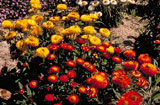|
[Front Page] [Features] [Departments] [SGAP Home Page] [Subscribe]

The Golden Everlasting
John Knight
Editors' Note: Taxonomic revision of the Australian Daisies over the past few years has resulted in many name changes. At the time that this article was written, the Golden Everlasting was known as Helichrysum bracteatum, however, the plant has now been transferred to a new genus and is known as Bracteantha bracteata. As the new name has been generally accepted, it has been used in the article.
Bracteantha bracteata is a most variable and widespread plant, found on the margins of dry rainforest in north Queensland, through to coastal areas of Western Australia, and seemingly every imaginable habitat in between except wet or heavily shaded areas. They generally flower from spring to autumn, although those varieties which occur in arid inland areas flower in the cooler months.
Plants may be either annual, or woody perennials. The specific name "bracteata" refers to the prominent and numerous, dry, papery bracts, which are often incorrectly referred to as petals.
In the early 19th century, noted East German horticulturist Herren Ebritsch, at Arnstadt, developed many unusual colour forms by intensive breeding of the annual varieties, and these were widely distributed in European gardens in the 1850s. These varieties known as Strawflowers, have globular heads, the bracts of which are coloured maroon through to bronze. The bracts remain cupped around the flowers rather than opening out flat to the perfect flower head of Golden Everlasting. Seed of the Strawflowers is still commonly available. Variability of wild populations of Bracteantha bracteata is seen in vigour, foliage and flower.

A massed display of Strawflowers at the National Botanic Gardens in Canberra. Select the thumbnail image or plant name for a higher resolution image (50k).
The annual varieties may grow from 30 cm to 1.5 m high, usually well branched but more or less erect. Foliage may be 20 mm long, but only 1 mm wide, or up to 100 mm long and 25 mm wide, whilst the flowers vary from 20 mm to 50 mm across.
Plants are easy to establish from seed sown following autumn rains and flowering can be expected to commence about October/November in Melbourne conditions. For best results, choose a situation with full sun, and well worked soil into which some complete fertiliser has been incorporated. Place plants at 30 cm centres, and keep well watered during establishment period. Light feeding each month with a liquid fertiliser will produce healthy and bushy plants which reward the grower with heavy flowering for six months or more, depending on the severity of the season.
Plants may also grow well in dappled shade, but, depending on available light, may grow taller and produce smaller or fewer flowers. To overcome this, prune lightly but regularly to promote bushiness, and use a low nitrogen fertiliser when preparing the ground.
Picking flowers for decoration or drying will encourage further flower production, but be sure to leave some flowers to produce seed for next year. Seed may be collected and stored for sowing in autumn, or be allowed to disperse naturally, where it will pop up in the most delightful places. It is unlikely to germinate in areas where the soil is heavily compacted or heavily mulched with organic material. However, it germinates well in gravelled areas.
Seed is ready to collect when the bracts have reflexed slightly and the centre of the flower becomes downy, like a dandelion. It should come away from the flowerhead with no effort. When storing, be sure the seed is dry and free from insects. Store in paper bags or envelopes in a dry area. Seed is likely to be available from various distributors of Australian plant seed and various groups of the Society for Growing Australian Plants.

The classic shape of the normal form of Bracteantha bracteata. The common name of "Paper Daisy" is derived from the papery bracts around the central cluster of small flowers. Select the thumbnail image or plant name for a higher resolution image (36k).
Plants are readily propagated from cuttings of firm young wood taken during spring to autumn. Wood produced during a flush of growth is most successful.
Most people are happy to grow the various perennial varieties, which are readily available from nurseries throughout Australia. Such is their popularity that even those nurseries that don't stock Australian plants will offer varieties of Bracteantha bracteata. Again, plants are extremely varied in their habit and habitat. There are tightly matted ground covers to robust rounded shrubs which may grow over 1 m high and, in some instances, up to 2 m wide.
The leaves are bright green to grey-green, somewhat hairy and velvety to touch. Size varies from 30 mm to 125 mm long, and 5 mm to 30 mm wide. Depending on the season, foliage may be sparse to dense, and it has been noted, in cultivation, that extra watering during summer will resurrect a I imp, tired plant in a short time.
|
| "Such is their popularity that even those nurseries that don't stock Australian plants will offer varieties of Bracteantha bracteata." |
|
Given good conditions, that is plenty of sun, and an open friable soil that is not allowed to dry out in summer, the perennial forms of Bracteantha bracteata are most attractive, free flowering shrubs, which may flower continually throughout the year. Regular light pruning is recommended to maintain bushiness, and cutting flowers for decoration is the ideal way to prune. Plants, including the forms described below, benefit from a regular light feeding during active growth.
Fresh flowers last a long time in water. If one wishes to dry the flowers, it is important to pick them when the first bracts have commenced to open, remove any foliage, and hang the flowers upside down in a dry, airy situation. Treated thus, the bracts will continue to open till all are arranged in perfect symmetry, displaying their true beauty for years.
The perennial forms of Bracteantha bracteata have been popular in cultivation for many years, but it seems those grown originally which included plants with orange, yellow, lemon and white flowers, have given way to the many named cultivars now propagated.
Bracteantha bracteata "Dargan Hill Monarch" was the first of these. It is a robust and large flowered selection from Cunningham's Gap, in the McPherson Ranges on the SE Queensland/north New South Wales border. Growing as a dense, rounded shrub to 0.8 m x 1-1.5 m, it has woolly grey foliage 70-120 mm x 20-30 mm. Very large, well displayed flowers, about 90 mm across, are held high above the foliage. Row upon row of shiny, bright yellow bracts surround up to 80 tiny orange florets. Plants may flower all the year if spent flowerheads are removed, but in cooler climates is generally restricted to the warmer months, October to April.
This cultivar is most hardy in cultivation, adapting to any well drained soil, in full sun or dappled shade. Plants respond to light feeding during vigorous growing periods, and pruning is beneficial. Heavy pruning should be avoided if possible, however, experience with plants in cultivation shows that plants will grow away well from hard pruning provided it is carried out early in the growing season, before the weather gets too hot.
Bracteantha bracteata "Diamond Head" is another well established cultivar. It was registered in 1977 by John Wrigley, then curator of the National Botanic Gardens, Canberra. This compact, prostrate plant is common on the coastal cliffs and bluffs around Diamond Head on the north New South Wales Coast. This selection is quite different from all other perennial cultivars, growing as a dense mat, about 0.1-0.2 m high and 0.5 m across. The long leaves are soft and fleshy, but covered with short bristly hairs, giving a slightly rough texture. Flower heads, with bright yellow bracts and orange florets, are about 30 mm across and held high above the foliage on stalks up to 100 mm long. Flowers during the warmer months, October to April.
|
| "Plants may become less thrifty and untidy if not pruned correctly." |
|
Plants may become less thrifty and untidy if not pruned correctly. Strong, new growth commences about mid-winter, and at this time most of the old foliage should be cut away to allow the new growth to come through. As is common with many coastal plants, Bracteantha bracteata "Diamond Head" will not tolerate poor drainage, and performs best in full sun. It makes an excellent rockery plant. In areas where heavy frosts are experienced, cutting away the old growth should be delayed to afford protection to the new growth.
Bracteantha bracteata "Princess of Wales" is a more recent introduction by the National Botanic Gardens. Named in honour of Her Royal Highness on the occasion of her visit to the garden in November 1985, this cultivar is a spontaneous hybrid between Bracteantha bracteata "Dargan Hill Monarch" and a coloured annual cultivar. Selected as having special merit, it is a bushy free flowering plant growing about 0.6 m x 0.6 m, with bright green foliage.
Rich golden yellow flowers are about 60 mm across, and borne in profusion from September to April. Whilst of a more compact habit than the other cultivars, Bracteantha bracteata "Princess of Wales" still benefits from light pruning during the growing season to encourage still more flowers. An ideal size for a small rockery, it would also make an excellent border plant, adapting to most aspects and soils. Again, full sun for heavy flowering.
Bracteantha bracteata "Cockatoo" is similar to Bracteantha bracteata "Dargan Hill Monarch" in size and foliage, but the flower heads, to about 70 mm across have light lemon bracts surrounding up to 200 orange florets. Bracteantha bracteata "Dargan Hill Monarch" is one parent, the other being a white flowered perennial plant. A well drained sunny spot will ensure a compact habit, with the plant growing to about 1 m x 1 m. Flowers may be produced throughout the year with light pruning.
Other cultivars include: Bracteantha bracteata "Lemon Monarch"; Bracteantha bracteata "White Monarch"; Bracteantha bracteata "Golden Bowerbird"; Bracteantha bracteata "Barleythorpe"; Bracteantha bracteata "Hastings Gold"; As I have not tried these, I cannot comment on their suitability for garden cultivation. However, any Bracteantha bracteata cultivar is likely to be successful if treated as for those described.
This article is reproduced from the September 1990 issue of the "Australian Plants", journal, published by the Society.
John Knight is currently the superintendent of the Eurobodalla Botanic Gardens at Batemans Bay on the New South Wales south coast. He has been growing and propagating Australian plants since the early 1970s and was formerly the manager of Austraflora Nursery in Melbourne and curator of the Karwarra Australian Plants Garden also in Melbourne.
 [Front Page] [Features] [Departments] [SGAP Home Page] [Subscribe]
[Front Page] [Features] [Departments] [SGAP Home Page] [Subscribe]
Australian Plants online - September 1996
The Society for Growing Australian Plants
|